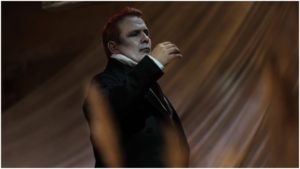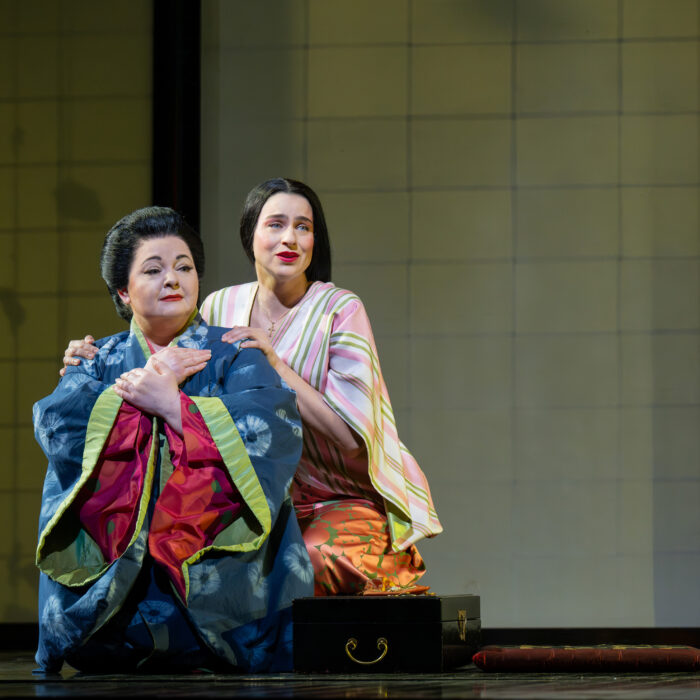
OperaGlass Works 2021 Review: The Turn of the Screw
A Skin-Crawling, Clever Version of Britten’s Supernatural Masterpiece from Wilton’s Music Hall
By Benjamin Poore(Credit: Laurie Sparham)
In every theatre there is a “ghost light.” It is a single lamp that shines in the middle of the stage when a theatre is deserted. In London, these lights have been doing their duty for longer than most had hoped. The ghost light is there to keep performers and technicians safe when the theatre is in darkness, to stop them plunging into the pit, or careening into props and set.
Right now they warn audiences to stay away. But theatrical types are a superstitious lot, and the “ghost light,” it is said, shines there to allow the specters that inhabit every theatre to perform, appeasing them thereby; in this way they are a haunting reminder of absent friends and colleagues who should be on stage but, right now, are not. Perhaps, too, they represent the flickering hope that one day the stalls will be filled again.
OperaGlass Works’ new production of Benjamin Britten and Myfanwy Piper’s “The Turn of Screw” begins with this same light, glowing eerily on Wilton’s Music Hall’s east London stage. It is obviously apt for this spooky masterpiece, not least because this production was originally slated for spring 2020, and now realized on film. It is as if the ghosts of the abandoned theatre have come out to play. In the work’s Prologue, the camera followed tenor Robert Murray onto the darkened stage and saw him tentatively strike the piano that brings the score to life.
A Breathtaking Realization
In this version, directors Eliza Thompson Selina Cadell recruited Dominic Best to bring their production into the medium of film. The setting is the artfully dilapidated nineteenth-century Wilton’s Music Hall, with its bare brickwork, rickety furniture, and unvarnished wood. OperaGlass Works offered a dazzling, intimate version of ‘The Rakes’ Progress’ in 2018, and the promise of John Wilson, a star conductor of twentieth-century popular orchestral repertoire, made this a hotly anticipated show.
The run-down look – designs and lighting by Tom Piper and Lewis Hannaby – gives the show a threatening, catastrophic feel; scenes take place in the auditorium, which is strewn with threateningly phallic and desiccated clumps of reeds and grasses, and in stark, distressed anterooms and corridors adjoining it. Miles and Flora play amongst the ruins of what feels like an abandoned house. Trees appear to have burst into the auditorium as if a striving primal force is claiming the house back, idyllic and threatening by turns.
Between scenes we see camera technicians and stagehands assembling and moving equipment, engineers at sound desks, the glimpse of a makeup artist, or the signers idling before a take. In one respect it is a gentle tribute to the unseen but essential parts of theatrical production, who face the same struggle right now as the musicians and performers we do see.
But it is also an ingenious metaphorical realization of the story’s animating energies, giving us a sense that there is much going on behind the proverbial scenes in the house: its pleasant bourgeois surface is an illusion, supported by machinations at odds with appearances. Bly house is a lie. In later interludes, as the equipment seems to malfunction and the technicians lose control, the implication is that the ghosts of the opera start to take over the production themselves. Perhaps the thespians are right to be so superstitious after all.
The musicians are often glimpsed obliquely, as something sinister in our peripheral vision, further adding to the mood of creeping terror. A violinist is blurred behind the window through which Quint will later appear; others appear only from behind, or through smudged lenses; John Wilson is seen only as a disembodied head, through a fuzzy stage monitor. In an especially atmospheric sequence, bass clarinet and flute duet illuminated by only the ghost light.
The resources of film bring much to the realization of this opera – a fine homage to a composer whose career would be so intimately involved with television, not least in “Owen Wingrave.” An eerily atmospheric sequence sees Quint’s paranoid hissing his worries about the letter written by the Governess’ as a wholly disembodied voice, as if in Miles’ head, as the camera jerks nervily; indeed, handheld camerawork from early on in the show give the whole thing a disorienting, panicked feel, and underline the score’s twelve-tone claustrophobia.
The moment Quint appears at the window in Act one is surely an homage to Michael Redgrave’s terrifying apparition in 1961’s adaptation “The Innocents,” underscored by Rhian Lois’ passing similarity, in look, hair, and dress, to Deborah Kerr. At times the camera prowls the auditorium, watching from above, placing us in Quint’s menacing perspective. The most striking effects are saved for the final scene, where the color palette shifts blue and the perspective distorts and distends, whose final struggle over Miles’ soul unfolds in the cold stark light.
A Formidable Cast
Wilson’s conducting of the Sinfonia of London is vivid and energetic, supported by some dazzling piano-playing. Percussion is crisp and vital; strings feral and seething in the “Soliloquy” scene. Celesta and harp chill and glitter in equal measure, whilst the horn lines that accompany Quint are positively priapic.
Rhian Lois’ Governess was lustrously voiced and compellingly musical, treading a fine line between innocence and experience with a careful control of timbre. Her characterization treads a fine line between naivety and worry, and her growing unease and desperation are palpable, intensified in her scenes with the cagey Mrs Grose, sung by Gweneth Ann Rand. Her scenes with Miles, where she finds herself wrong-footed, are electric. As the opera whispers to its terrible close, Lois was truly pathetic and chilling.
Robert Murray’s Quint had the traditional shock of red hair and white face but brings his own vocal style to the role. He was sweet and glistening in the many lyrical moments, more oily and seductive than in the ethereal vocal template set down by Peter Pears. But there was a lithe, aggressive muscularity too, a hint of threatening sexuality, especially in his melismatic repetitions of ‘Miles’. Some slightly cartoonish gestures struck the only slightly dull note of an otherwise gripping performance. His evil machinations were supported by Francesca Cheijina’s Miss Jessel in a velvety and haunting portrayal.
Miles and Flora are the heart of the show and were presented with remarkable focus and nuance by Leo Jemison and Alys Mererid Roberts. Their scene in the church – ‘The Bells’ – rose to a fever pitch of truly demonic intensity. Roberts conveyed Flora’s traumatized, troubled self with vocal lucidity – her voice hovering between adult and teenage with uneasy poise – and deft acting; her look of dread and shame during Miles’ ‘Malo’ song was chilling, and so too her pathological play with her dolly (‘Dolly must sleep when I tell her to!’) Jemison’s Miles had moments of threatening charisma and maturity, as if in terrible imitation of Quint; he marshaled a cold, hard sound and claustrophobic lyricism.
The ceremony of innocence is drowned indeed. OperaGlass Works have offered a thrilling realization of opera on film.
The ‘Turn of the Screw’ is available through Marquee TV .


